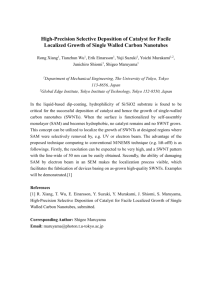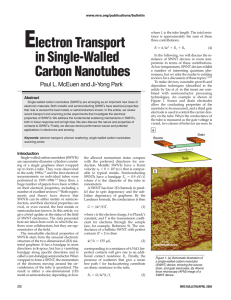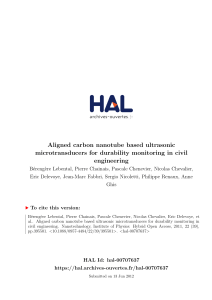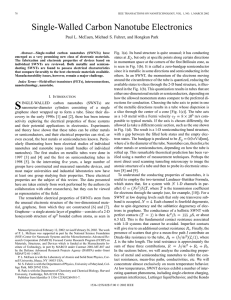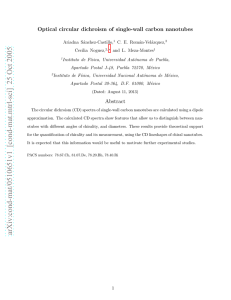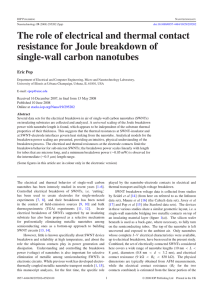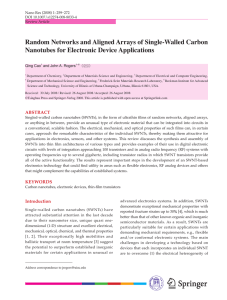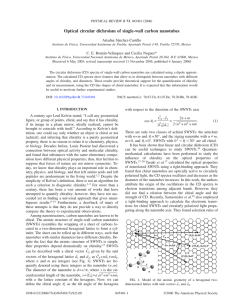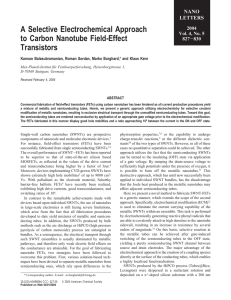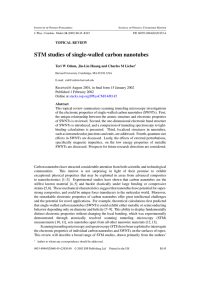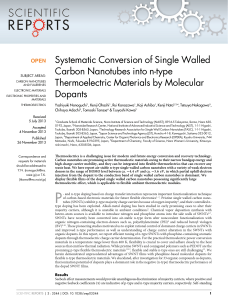FULLERENE PIPES
advertisement
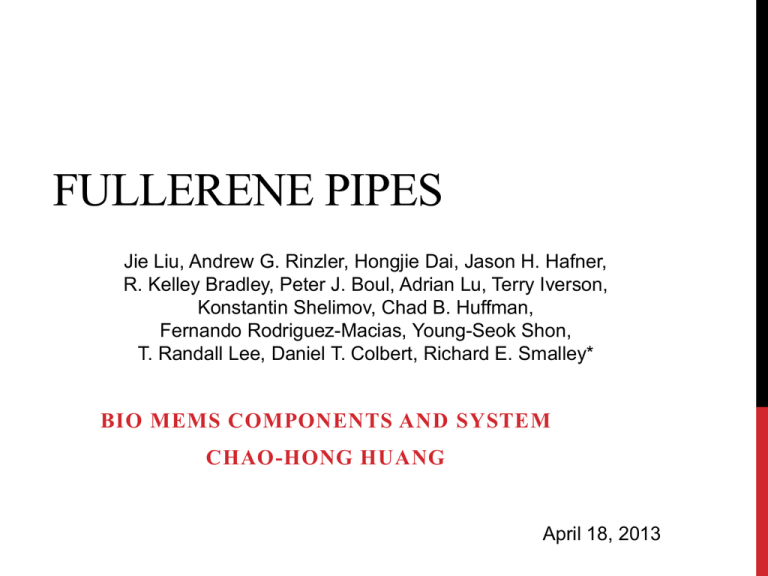
FULLERENE PIPES Jie Liu, Andrew G. Rinzler, Hongjie Dai, Jason H. Hafner, R. Kelley Bradley, Peter J. Boul, Adrian Lu, Terry Iverson, Konstantin Shelimov, Chad B. Huffman, Fernando Rodriguez-Macias, Young-Seok Shon, T. Randall Lee, Daniel T. Colbert, Richard E. Smalley* BIO MEMS COMPONENTS AND SYSTEM CHAO-HONG HUANG April 18, 2013 OUTLINE Abstract Introduction Experimental Method Results and Discussion Conclusion ABSTRACT Single-wall fullerene nanotubes(SWNTS) were converted from nearly endless, highly tangled ropes into short, open-ended pipes that behave as individual macromolecules. Raw nanotube material was purified in large batches, and the ropes were cut into 100- to 300-nanometer lengths. The resulting pieces formed a stable colloidal suspension in water with the help of surfactants. These suspensions permit a variety of manipulations,such as sorting by length, derivatization, and tethering to gold surfaces. INTRODUCTION(1/3) Carbon nanotubes has unique electronic (1) mechanical (2) properties combined with chemical stability. Mechanical properties: Heat, Corrosion-resistant,Impact resistance, Thermal conductivity. Electronic properties : Conductive Carbon nanotubes has two types : Single-wall carbon nanotubes(SWNTs) Multi-walled carbon nanotubes (MWNTs) INTRODUCTION(2/3) SINGLE-WALL CARBON NANOTUBES(SWNTS) MULTI-WALLED CARBON NANOTUBES (MWNTS) INTRODUCTION(3/3) The SWNTs for this study were prepared by a scaled-up version of the laser-oven method described previously. Although this method produces fullerene nanotube material of lower quality (50%) than the previously described method (70 to 90%), it has the advantage of being able to produce 20 g of material in 2 days of continuous operation. This as-grown material contains a substantial fraction of nanoscale impurities (bucky onions, spheroidal fullerenes,amorphous carbon, and others) that are difficult to separate from the nanotubes once they have been cut. (purified) EXPERIMENTAL METHOD(1/2) Laser-oven method: The synthesis could be carried out in a horizontal flow tube under a flow of inert gas at controlled pressure. In this setup the flow tube is heated to ~1200°C by a tube furnace. Laser pulses enter the tube and strike a target consisting of a mixture of graphite and a metal catalyst such as Co or Ni. SWNTs condense from the laser vaporization plume and are deposited on a collector outside the furnace zone. EXPERIMENTAL METHOD(2/2) Purification: we developed a purification method that consists of refluxing in 2.6 M nitric acid and resuspending the nanotubes in pH 10 water with surfactant followed by filtration with a cross-flow filtration system . Passing the resultant purified SWNT suspension through a polytetrafluoroethylene filter produced a free-standing mat of tangled SWNT ropes—a “bucky paper.” Typical scanning electron microscope(SEM) images near and at a torn edge of a paper are shown in Fig. 1, B and C, respectively. As is evident in Fig. 1C, the tearing process produces a substantial alignment of the SWNT ropes. The net yield of purified fullerene fibers from this method depends on the initial quality of the raw material,with typical yields in the range of 10 to 20%by weight. RESULTS AND DISCUSSION(1/5) RESULTS AND DISCUSSION(2/5) The 3:1 concentrated H2SO4:HNO3 mixture was chosen for the oxidizing acid in this cutting operation because it is also known to intercalate and exfoliate graphite. We suspected that it may similarlyhelp to separate the cut tube pieces from the underlying tubes in the rope, thereby exposing these inner SWNTs to new sonication-induced damage and subsequent further cutting. As shown in Fig. 2, the result is efficient cutting of the SWNT rope material into thinned rope pieces and individual cut tubes. RESULTS AND DISCUSSION(3/5) RESULTS AND DISCUSSION(4/5) To ensure that the cut nanotube pieces were themselves molecularly perfect and chemically clean, we subjected them to further etching in acid without sonication. As expected for open-ended tubes, that is,fullerene pipes, the length distribution shortened systematically with exposure time to the acid. For example, in 3:1 concentrated sulfuric and nitric acid at 70°C,we found that the average cut nanotube shortened at a rate of roughly 130 nm hour-1 (Fig. 3). At 70°C in a mixture of concentrated sulfuric acid and 30% aqueous hydrogen peroxide (4:1 by volume), the shortening rate was roughly 200 nm hour-1 . RESULTS AND DISCUSSION(5/5) we developed an electrodeposition technique that drives essentially all nanotubes in suspension onto the surface of highly oriented pyrolytic graphite (HOPG), which was subsequently scanned by atomic force microscope (AFM). CONCLUSION(1/2) CONCLUSION(2/2) We assayed this chemistry by using the free thiol end to tether the end of the nanotube to a 10-nm diameter gold particle. AFM imaging revealed that most tubes derivatized in this way have a single gold particle bound to at least one of their ends, as demonstrated in Fig. 5. Similar results were obtained regardless of whether the gold particles were exposed to the tubes before or after being deposited on HOPG. Control experiments verified that derivatization was necessary: Gold particles were seldom found at the ends of tubes without alkanethiol tethers. Attachment of such strategically designed binding groups may be very useful in directing assembly of fullerene tubes into molecular devices. THANK YOU FOR YOUR ATTENTION !



